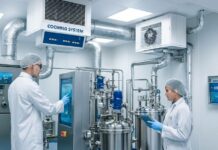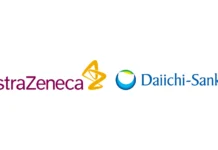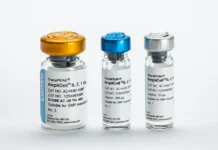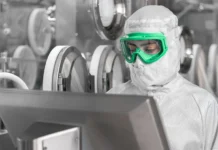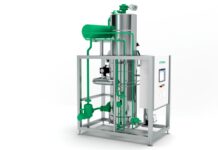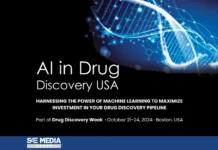The pharmaceutical fine chemicals market is all set for unprecedented growth and is projected to reach a staggering $235 billion by the end of the decade. Driven by advances when it comes to the healthcare sector, especially in the realms of biopharmaceuticals along with personalized medicine, the pharmaceutical fine chemicals market has gone on to emerge as a cornerstone when it comes to worldwide drug development.
Let us look into the trajectory of the market, the innovations pertaining to technology, as well as the barriers that are shaping its future.
A brief market overview
The pharmaceutical fine chemicals market, which is valued at $235 billion by 2030, is expected to grow at a CAGR of 6.5% from 2024 till the end of the decade. These specialized chemicals, which are known for their high purity as well as precise compositions, go on to form the backbone when it comes to drug discovery and its production. Their application spans targeted therapy, biologics, and small molecular drugs.
So why is the emphasis on fine chemicals now?
The pharmaceutical fine chemicals market has gone on to see remarkable growth in recent years and is driven by the evolving healthcare needs, regulatory shifts, and technological enhancements. All these trends are shaping the competitive spectrum and also dictating future directions when it comes to industry stakeholders.
-
Customized medicine as well as targeted therapy
One of the most transformative growths in the pharmaceutical industry happens to be the rise in personalized medicine, which tailors the treatments to the environmental, genetic, and lifestyle factors of individual patients.
It is well to be noted that fine chemicals are indeed crucial when it comes to developing active pharmaceutical ingredients that happen to meet the right requirements of such therapies. Drugs, when it comes to precision-based treatments such as immunotherapy for cancer, demand ultra-pure as well as highly specific chemicals in order to ensure efficacy and, at the same time, minimal side effects. This trend has gone on to create a huge surge when it comes to demand for customized synthesis as well as innovative chemical solutions, especially in terms of autoimmune and oncology diseases.
-
Emphasis on sustainability along with green chemistry
Sustainability has gone on to become a cornerstone when it comes to the pharmaceutical fine chemical sector. Regulatory bodies, along with governments, are actively pushing for production practices that are eco-friendly and that minimize the overall environmental effect. For example, the European Union’s Green Deal, along with the US Environmental Protection Agency’s focus when it comes to green chemistry, are indeed prompting manufacturers to go ahead and embrace a cleaner and more sustainable process. This happens to include the usage of renewable raw materials, energy-efficient manufacturing, and a decrease in hazardous waste. Companies that happen to take these practices in their way are not just making sure that there is regulatory compliance that is met, but at the same time, they are also strengthening their brand image along with market appeal.
-
Regional market dynamics
The global pharmaceutical fine chemicals market goes on to showcase a prominent regional disparity, with North America and Europe leading when it comes to technology innovation and regulatory stringency. Apparently, North America holds the highest market share, which is 35%, thanks to its super solid pharmaceutical infrastructure and also early adoption when it comes to advanced chemical technologies. Europe follows second with a robust stress on environmental sustainability along with high-quality standards. On the other hand, the Asia Pacific region is indeed emerging as a growth hub and is led by cost-effective manufacturing along with government initiatives in order to promote domestic APIs as well as chemical production. Countries such as China and India are rapidly closing the gap when it comes to the Western market due to their skilled workforce along with expanding R&D facilities.
-
Partnership initiatives in research and development
The global pharmaceutical giants are increasingly partnering with fine chemicals manufacturers in order to speed up the drug development process. These collaborations often involve the co-development of new chemical entities along with optimizing existing production methods. This partnership model enables pharmaceutical companies to leverage the unique expertise of fine chemical players, improves efficiency, and reduces cost while at the same time fine chemical manufacturers benefit from balanced revenue streams and shared technological enhancements.
Technology along with innovation insights within the pharmaceutical fine chemicals market
Technological innovation happens to be a major driver of growth within the pharmaceutical fine chemicals market. There are advanced technologies that are indeed redefining the production spectrum by helping with higher precision and adaptability along with sustainability.
-
The high-purity synthesis
One of the core needs in pharmaceutical production is attaining ultrahigh purity levels in fine chemicals, often exceeding 95%. Innovative synthesis technologies, like advanced crystallization techniques and enzymatic catalysis, are being embraced in order to meet strict standards. These technologies make sure that the impurities are minimized, which is, by the way, very critical for the safety and efficacy of any drug formulation, especially biological and targeted therapies.
For instance, the low-temperature and low-pressure synthesis methodology, which goes on to preserve the stability of sensitive molecules, happens to be turning increasingly important in biopharmaceutical development. This focus on priority as well as position is specifically vital for drugs that address intricate diseases such as neurodegenerative disorders and cancer.
-
The influx of artificial intelligence and machine learning in chemical design
The integration when it comes to artificial intelligence along with machine learning is indeed revolutionizing the pharmaceutical fine chemicals industry. The AI-driven algorithms are now used in order to forecast molecular interactions, optimize synthesis pathways, and design new chemical entities. These tools go on to significantly decrease the time along with costs that are associated with traditional drug development. For example, AI can, in a very rapid way, stimulate thousands of synthesis routes in order to identify the most sustainable and effective option. This is especially advantageous when it comes to creating highly specialized chemicals for customized medicine, where speed along with accuracy is a must.
-
Green chemistry along with process optimization
The adoption when it comes to green chemistry principles is not just a trend but a requirement in today’s environmentally conscious world. Fine chemical manufacturers happen to be investing in the process of optimization in order to decrease their carbon footprint along with hazardous waste. Techniques such as biocatalysis, solvent-free synthesis, and usage of reasonable raw materials are gaining ground. Closed-loop manufacturing systems that go on to recycle waste products within the production cycle are being executed so as to elevate sustainability practices. Companies that adopt these practices are most likely to achieve regulatory compliance in a more seamless way and position themselves as leaders when it comes to the transition to eco-friendly pharmaceutical production.
-
Consistent manufacturing along with automation
Traditional batch manufacturing processes are indeed being replaced now by continuous manufacturing systems within the pharmaceutical fine chemicals industry. Continuous processes that involve an uninterrupted production of chemicals go on to give out several advantages as compared to batch processes, including higher efficiency, decreased product downtime, and bettering the skill ability. Automation is also playing a very crucial role when it comes to streamlining production. Advanced sensors as well as real-time monitoring systems help manufacturers to maintain consistent quality, which ensures reduced downtime. This is especially very imperative for high-value biopharmaceuticals, where even minor shifts can compromise when it comes to the integrity of the product.
-
The rising technologies when it comes to buying pharmaceutical fine chemicals
As the biopharmaceutical sector continues to grow, new technologies are indeed emerging in order to meet the unique demands of the sector. For instance, fine chemicals are used in cell and gene therapy and often require precise and scalable production methods. Microfluidic technology, which enables the decision manipulation of fluids on micro levels, is also getting used in order to produce high chemicals for such cutting-edge therapy. Similarly, inventions when it comes to freeze-drying and lyophilization are ensuring the ability of chemicals that get used in factories for vaccine production. These technologies are especially very important in regions where limited cold chain infrastructure happens to be there, as they enhance the shelf life and, at the same time, the transportability when it comes to critical pharmaceutical products.
All these innovations as well as developments collectively highlight the dynamism of the pharmaceutical fine chemicals market. By taking into account advanced technologies, sustainability measures, and partnership strategies,
Industry stakeholders are not just addressing the present challenges, but at the same time, they’re also making sure to pave the path for long-term success in the healthcare landscape, which is evolving rapidly.
Major players as well as stakeholders
The pharmaceutical fine chemicals industry is throttled due to a mix of seasoned global players along with regional innovators. There are leading companies such as Dipharma Francis SRL, Hovione, and Siegfried Holding AG that contribute to the market’s cutting-edge advancements. Their investments when it comes to research and development, blended with strategic partnerships, make sure of a competitive edge.
Data along with forecast
The growth trajectory of the market happens to be underpinned by robust data.
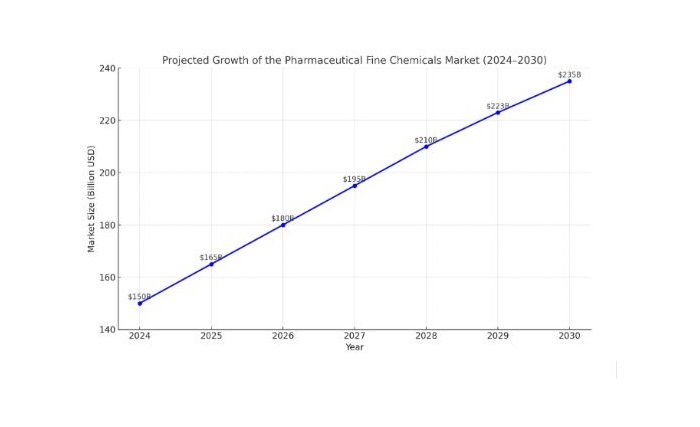 Challenges when it comes to the pharmaceutical fine chemicals market
Challenges when it comes to the pharmaceutical fine chemicals market
In spite of the promising growth trajectory, the pharmaceutical fine chemicals market is not exempt from prominent barriers.
-
Strict regulatory compliances
The pharmaceutical industry is heavily regulated because of its direct impact when it comes to drugs on human health. Regulatory bodies like the USFDA and EMA, as well as regulatory counterparts in emerging markets, go on to impose stringent guidelines when it comes to the production and environmental compliance of fine chemicals, as well as their purity. While these regulations make sure of safety and efficacy, they also increase the production cost and the development timelines. For example, attaining good manufacturing practice certifications or taking care of environmental impact assessments needs significant investments when it comes to infrastructure, documentation, and, of course, personnel training.
-
High cost of production
Production of fine chemicals with the required high purity along with specificity happens to be a very complex and costly process. Advanced synthesis technologies, along with specialized equipment and, of course highly skilled workforce, add to the capital expenditure. They also add to the operational expenses too. In addition to this, the focus on sustainability has mandated the adoption of eco-friendly processes like renewable energy usage or even techniques related to waste reduction that further inflate the costs. Smaller or, for that matter, mid-size players often find it very, very challenging in order to compete with firms that can absorb these kinds of heavy expenses in a more effective and efficient way.
-
Disruption caused to the global supply chain
The pharmaceutical fine chemicals industry functions in a very intricate global supply chain. Raw materials along with intermediate products happen to be sourced from various regions, making this industry very vulnerable to natural disasters, pandemics, and due political imbalances. The COVID-19 pandemic offered a stark example of supply fragility since the international trade barriers, along with lockdown, disrupted the availability of major raw materials. The dependence on specific regions like India or China when it comes to bulk drugs and APIs bloats the supply bottleneck risk.
What are the opportunities that are available in the pharmaceutical fine chemicals market?
-
Asia Pacific as a growth hub
Emerging economies, especially in Asia Pacific, happen to be playing a very vital role in the pharmaceutical fine chemicals market. India and China have gone on to establish themselves as prominent global players when it comes to supplying APIs as well as intermediates because of their cost-effective manufacturing processes along with growing investments when it comes to high-quality production capabilities.
-
Expansion of biopharmaceuticals
Biopharmaceuticals, which include monoclonal antibodies, vaccines, as well as cell and gene therapy, are becoming very important and dominant when it comes to the drug development pipeline. These therapies need specialized fine chemicals in order to attain specificity and precision, which are both necessary for their efficacy. The biopharmaceutical sector goes on to represent a very profitable avenue as far as fine chemical manufacturers are concerned who are willing to innovate along with it and also diversify their portfolios.
-
Focusing on stability
Due to rising regulatory along with consumer pressure to reduce environmental footprint When it comes to pharmaceutical manufacturing, there is indeed a growing emphasis when it comes to sustainable practices. The adoption of green chemistry, which happens to focus on eco-friendly synthesis processes and waste reduction, goes on to offer a prominent opportunity when it comes to manufacturers in order to align them with global sustainability goals.
Future outlook when it comes to the pharmaceutical fine chemicals market
The pharmaceutical fine chemicals market And its future is intrinsically blended with advancements in regulatory shifts and healthcare, along with global economic trends. All the indicators go on to suggest a very dynamic spectrum that is filled with promising opportunities in terms of growth, partnerships, and innovation.
-
Elevated partnerships through the value chain
The growing complex nature when it comes to drug discovery as well as development requires a much closer partnership between pharmaceutical companies and fine chemical manufacturers. Collaborations are expected to expand by making sure that manufacturers get involved early when it comes to the drug development cycle in order to customize their chemical solution to certain specific needs. The integration will help with a much faster time to market in terms of new therapies, especially when it comes to addressing diseases that are rare and also personalized medicines.
-
Green chemistry advancement
Sustainability will obviously remain a very dominant theme throughout the coming years. Regulatory bodies are likely to tighten the environmental benchmarks further, thereby prompting the green practice adoption throughout the industry. Manufacturers who happen to invest in renewable energy sources, recyclable technologies, and biodegradable solvents will not just comply with these kinds of regulations but also position themselves as the yardstick in sustainable pharmaceutical production.
-
Diversification, which is regional
While North America, along with Europe, will continue to dominate the market because of their established pharmaceutical sectors, the fast growth of the Asia Pacific region is anticipated to reshape the global supply chain dynamics. Governments in countries like China, India, and South Korea are actively promoting domestic manufacturing when it comes to APIs along with fine chemicals in order to reduce their dependence on imports. The regional diversification is most likely to lead to stronger supply chains and a very competitive global spectrum.
-
Growing investment within biopharmaceuticals
It is well to be noted that biopharmaceuticals will continue to drive the growth of the market by accounting for a major portion when it comes to new drug approvals over the next decade. Fine chemical manufacturers that sync their offerings with the requirements of pharmaceutical companies, like high-purity reagents and custom synthesis solutions, are going to find themselves in the forefront of this kind of expansion.
-
The cutting-edge technology integration
Integration of advanced technologies such as machine learning and AI in chemical synthesis as well as drug development is going to redefine the market. Predictive modeling tools that are powered by AI can go on to streamline the discovery when it comes to new chemical entities and also optimize the production processes by decreasing the cost and enhancing the efficiency. These kinds of innovations will play a very critical role when it comes to meeting the growing demand as far as high-quality pharmaceutical fine chemicals are concerned.
-
Advent of new therapeutic areas
As the pharmaceutical sector goes on to discover new therapeutic models like RNA-based therapies, precision oncology treatment, and microbiome-based drugs, the demand when it comes to specialized fine chemicals is only going to increase. These kinds of emerging fields represent opportunities that are untapped when it comes to chemical manufacturers who are willing to invest in research and development along with cutting-edge production capacities.
So, what lies ahead?
The pharmaceutical fine chemicals market is at a very crucial juncture and is driven by advances when it comes to technology, healthcare, and sustainability. While the challenges, like regulatory compliance along with supply chain vulnerabilities, still go on, the opportunities outweigh the risks. Companies that take into account innovation, invest in green practices, and make utmost use of regional strengths will not just thrive but at the same time will also play a critical role when it comes to global healthcare.



